Choosing the Venue
Your choice of reception hall should consider your budget, wedding theme and personal tastes. Many couples choose to have their reception in the fellowship building associated with the church they are married in. However, many churches impose restrictions on the use of alcohol or music on church grounds, so make sure you check this out before booking this type of hall. You don’t want any last minute surprises!
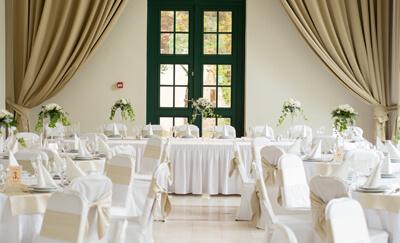
Reception halls come in all shapes & sizes but some of the finer halls can be found in the best hotels.
There are many halls available for rent just for receptions. Before signing a contract, make sure the hall is large enough to accommodate the number of guests at your reception, that it has appropriate power supply for lighting and music and that it has a kitchen for catering, if necessary, or an appropriate power supply for warming trays.
It is also nice to rent a hall that has an area for the bride and groom to change into their traveling clothes at the end of the reception.
Also ensure that the temperature of your building is comfortable. Remember there will be a number of people dancing and mingling in close quarters along with incandescent or spot lighting, which can raise temperatures considerably. Make sure you locate the thermostat and know how to operate it before the day of the reception.
You can also choose to have your reception in more unconventional places such as a public park, a houseboat or rented yacht, or even your own back yard. In fact, receptions were traditionally held at the bride’s home! If you choose an outdoor or other unconventional venue, make sure you have portable power generators, if necessary, and that there are restroom facilities nearby for the comfort of your guests.
How to Decorate
Generally, reception decor is determined by budget and theme. A great way to save money is to reuse the flowers from the church at your reception to add punch to the gift table, the guest book sign-in area, or the head table. As decorations are an entirely personal matter, consider the theme of your wedding when deciding on what to choose for your reception. Some themes are simply color-oriented, which could be as easy as colored tablecloths, colored flower arrangements or streamers and balloons. Other themes, such as island, woodland, or Celtic lend themselves to more elaborate and interesting decor.
Considering Wedding Favors
Most receptions offer the guests a memento of the day in the form of a wedding favor. These can cost as little as $1 per guest, or range as high as $30 or more. You can choose to assemble the favors yourself or have a company package them for you. Either way, remember that favors will be cheaper when purchased in bulk. If you choose a high-end favor, you can save money by giving one per couple and packaging it in a box to leave between their plates at the dinner.
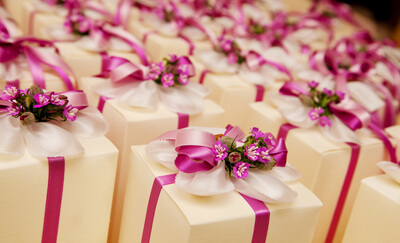
Leaving every guest with a memento of the day is a lovely gesture, made better when well presented.
No matter what type of favor you choose--from simple, edible gift to high-end boutique choices--make sure it is packaged in a pretty, appealing manner. This can be a small box with personalized tags, or even simple cellophane wrappers.
There are several ways to distribute your favors once you have chosen the item that best represents you and your partner as a couple. You can place one at each setting at a table, set up one table with favors on it with a sign stating “Please Take One” or other appropriate phrase; or even hand them out yourself at the end of the evening.
Choosing Food.
The time of day of the reception determines the type of food to be served. A morning reception would indicate the serving of breakfast, an afternoon reception; brunch and an evening reception; dinner. Of course, of these, breakfast is the most budget-friendly meal and can be made quite creative with the addition of an omelet or pancake station where guests can create their own signature combinations. Other less standard types include a dessert reception or cocktail party reception for weddings later in the evening, or a tea reception for mid-afternoon weddings.
Once you choose the time of your reception, you can opt for either a full-service, sit-down meal (the most expensive option) or buffet-style service. You might even mix it up by choosing for some parts of the meal to be offered by waiters on a circulating basis.
Providing Drink
Most wedding receptions center around a series of toasts to the newly married couple. Alcohol is served at most receptions, but also make sure there is a selection of non-alcoholic drinks for children and others who prefer not to drink alcohol.
There are three standard ways to provide reception drinks. A cash bar, where guests pay for their own beverages; an open (or full) bar, where guests can drink unlimited alcoholic beverages; or a beer and wine service; where guests receive complimentary beer and wine only.
It is your reception, and you can feel free to personalize it as you see fit. Perhaps you would like to offer a signature cocktail for free (say, a pina colada for an island wedding) while any other drinks will be cash bar. Or you might offer a champagne service or whiskey tasting. The choice is up to you.
Depending on your choice of hall, you may be allowed to bring your own alcohol in for service to your guests. Generally, you will pay an “opening fee” to the hall for each bottle opened during your reception. Other halls require that you purchase your liquor through them and perhaps even use their bar staff. These are things that should be clearly stated in your contract with the hall. Make sure that you ask to see a liquor license for any hall in which you will be serving alcohol.
The Sound of Music
Music choices for a reception can range from a live band to a DJ to a playlist from your iPod depending on venue and budget. Consider also the theme of your wedding when making music choices. A steel drum band might be a great accompaniment to an island-themed wedding, while a group of Irish folk singers would complement a Celtic affair.
If you choose live music, make sure that your reception hall is suitably large. It must also have room for people to dance without being uncomfortably crowded. Think, also, of power needs for musicians or even a DJ’s speakers when booking your hall. Also check into local noise ordinances to ensure that you are within local limits.
Guest Etiquette
Although receiving lines (where the bride, groom and wedding party “receive” or greet each guest individually) are usually foregone in modern weddings, you are still required to meet and acknowledge all of your guests. The bride and groom can circulate separately or together, and even dancing can count towards socializing with your guests. Nothing gets people dancing like seeing the bride and groom out on the floor!
There are many ways to make guests feel special and included on your day. Besides signing a guestbook, you can leave a instant camera at each table and ask guests to take candid shots throughout the night. They can deposit the cameras in a basket as they leave to be developed by the bride and groom.
You can choose special people from your list to receive the flowers from the tables and other arrangements at the end of the evening or you can arrange little raffles or games to determine who “wins” the decorations.
For out-of-town guests, it is nice to provide a small bag of necessities as well as a travel brochure for events and places of interest in the area that they can see after the big day.
One of the best things to do for reception guests is to offer a cab service to take home those who have had a little too much to drink at the reception.
Did You Know?
In centuries past, most couples grew up within close distances and a wedding or handfasting would draw friends and relatives who would might travel for many hours to attend, even walking perhaps twenty or thirty miles. This, of course, meant leaving their own chores unmanaged for as long as the journey would take them, possibly resulting in hardship upon their return.
Feasting, drinking and dancing would occupy two or three days and it was thought only proper to provide a good meal, good drink and good entertainment to folk who cared for the couple enough to come so far at such cost.

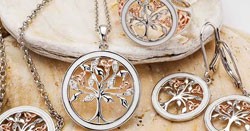
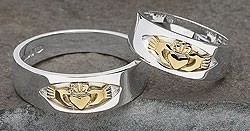
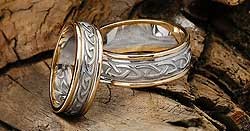
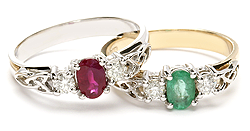
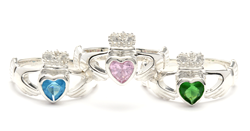
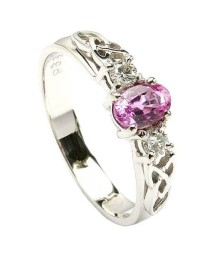 Pink Sapphire White Gold Ring
Pink Sapphire White Gold Ring 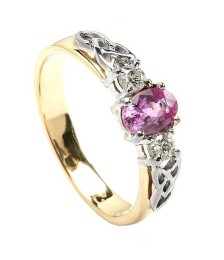 Pink Sapphire Engagement Ring
Pink Sapphire Engagement Ring 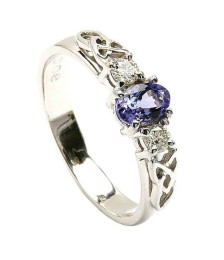 Tanzanite Engagement Ring
Tanzanite Engagement Ring 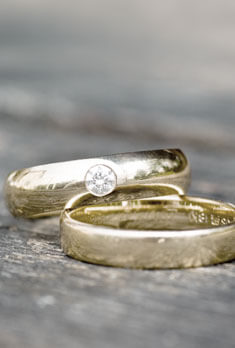

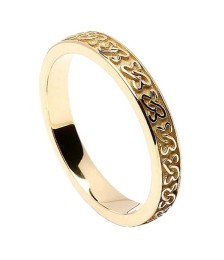 Celtic Hearts Wedding Band
Celtic Hearts Wedding Band 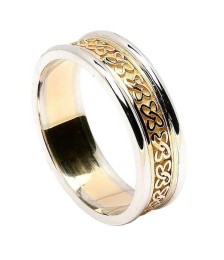 Celtic Hearts Band with Trim
Celtic Hearts Band with Trim 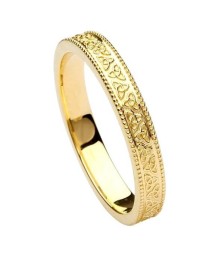 Trinity Knot Wedding Band
Trinity Knot Wedding Band 